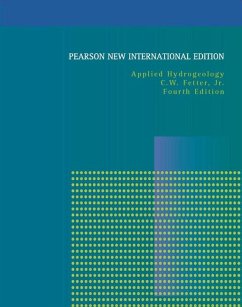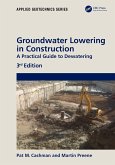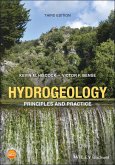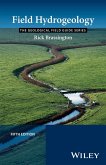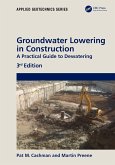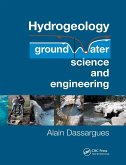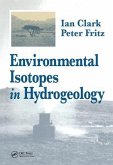- Broschiertes Buch
- Merkliste
- Auf die Merkliste
- Bewerten Bewerten
- Teilen
- Produkt teilen
- Produkterinnerung
- Produkterinnerung
The text is designed for advanced undergraduate or beginning graduate-level courses in hydrology, groundwater hydrology, hydrogeology, and civil engineering. This best selling text gives students a balanced examination of all facets of hydrogeology. The text stresses the application of mathematics to problem solving rather than derivation of theory. It provides a balance between physical and chemical hydrogeology. Numerous case studies cultivate student understanding of the occurrence and movement of ground water in a variety of geologic settings.
Andere Kunden interessierten sich auch für
![Groundwater Lowering in Construction Groundwater Lowering in Construction]() Pat CashmanGroundwater Lowering in Construction97,99 €
Pat CashmanGroundwater Lowering in Construction97,99 €![Hydrogeology Hydrogeology]() Kevin M. Hiscock (University of East Anglia)Hydrogeology103,99 €
Kevin M. Hiscock (University of East Anglia)Hydrogeology103,99 €![Coastal Hydrogeology Coastal Hydrogeology]() Jimmy Jiao (The University of Hong Kong)Coastal Hydrogeology68,99 €
Jimmy Jiao (The University of Hong Kong)Coastal Hydrogeology68,99 €![Field Hydrogeology Field Hydrogeology]() Rick Brassington (UK Newcastle University)Field Hydrogeology56,99 €
Rick Brassington (UK Newcastle University)Field Hydrogeology56,99 €![Groundwater Lowering in Construction Groundwater Lowering in Construction]() Pat CashmanGroundwater Lowering in Construction205,99 €
Pat CashmanGroundwater Lowering in Construction205,99 €![Hydrogeology Hydrogeology]() Alain Dassargues (Belgium University of Liege)Hydrogeology66,99 €
Alain Dassargues (Belgium University of Liege)Hydrogeology66,99 €![Environmental Isotopes in Hydrogeology Environmental Isotopes in Hydrogeology]() Ian D. ClarkEnvironmental Isotopes in Hydrogeology192,99 €
Ian D. ClarkEnvironmental Isotopes in Hydrogeology192,99 €-
-
-
The text is designed for advanced undergraduate or beginning graduate-level courses in hydrology, groundwater hydrology, hydrogeology, and civil engineering. This best selling text gives students a balanced examination of all facets of hydrogeology. The text stresses the application of mathematics to problem solving rather than derivation of theory. It provides a balance between physical and chemical hydrogeology. Numerous case studies cultivate student understanding of the occurrence and movement of ground water in a variety of geologic settings.
Hinweis: Dieser Artikel kann nur an eine deutsche Lieferadresse ausgeliefert werden.
Hinweis: Dieser Artikel kann nur an eine deutsche Lieferadresse ausgeliefert werden.
Produktdetails
- Produktdetails
- Verlag: Pearson Education Limited
- 4 ed
- Seitenzahl: 616
- Erscheinungstermin: 21. August 2013
- Englisch
- Abmessung: 269mm x 215mm x 43mm
- Gewicht: 1354g
- ISBN-13: 9781292022901
- ISBN-10: 1292022906
- Artikelnr.: 54828605
- Herstellerkennzeichnung
- Libri GmbH
- Europaallee 1
- 36244 Bad Hersfeld
- gpsr@libri.de
- Verlag: Pearson Education Limited
- 4 ed
- Seitenzahl: 616
- Erscheinungstermin: 21. August 2013
- Englisch
- Abmessung: 269mm x 215mm x 43mm
- Gewicht: 1354g
- ISBN-13: 9781292022901
- ISBN-10: 1292022906
- Artikelnr.: 54828605
- Herstellerkennzeichnung
- Libri GmbH
- Europaallee 1
- 36244 Bad Hersfeld
- gpsr@libri.de
(NOTE: Each chapter concludes with Notation, Analysis, and Problems.)
1. Water.
Water. Hydrology and Hydrogeology. The Hydrologic Cycle. Energy
Transformations. The Hydrologic Equation. Hydrogeologists. Applied
Hydrogeology. The Business of Hydrogeology (What Do Hydrogeologists Do All
Day?) Sources of Hydrogeological Information. American Society of Testing
and Materials Standards. Working the Problems. Solving Problems Using
Spreadsheets.
2. Elements of the Hydrologic Cycle.
Evaporation. Transpiration. Evapotranspiration. Condensation. Formation of
Precipitation. Measurement of Precipitation and Snow. Effective Depth of
Precipitation. Events during Precipitation. Events During Precipitation.
Stream Hydrographs. Rainfall-Runoff Relationships. Duration Curves.
Determining Ground-Water Recharge from Baseflow. Measurement of Streamflow.
Manning Equation.
3. Properties of Aquifers.
Matter and Energy (A Brief Review of Physics). Porosity of Earth Materials.
Specific Yield. Hydraulic Conductivity of Earth Materials. Permeameters.
Water Table. Aquifers. Water-Table and Potentiometric Surface Maps. Aquifer
Characteristics. Compressibility and Effective Stress. Homogeneity and
Isotropy. Gradient of the Potentiometric Surface.
4. Principles of Ground-Water Flow.
Introduction. Mechanical Energy. Hydraulic Head. Head in Water of Variable
Density. Force Potential and Hydraulic Head. Darcy's Law. Equations of
Ground-Water Flow. Solution of Flow Equations. Gradient of Hydraulic Head.
Relationship of Ground-Water-Flow Direction to Grad h. Flow Lines and Flow
Nets. Refraction of Flow Lines. Steady Flow in a Confined Aquifer. Steady
Flow in an Unconfined Aquifer.
5. Ground-Water Flow to Wells.
Introduction. Basic Assumptions. Radial Flow. Computing Drawdown Caused by
a Pumping Well. Determining Aquifer Parameters from Time-Drawdown Data.
Slug Tests. Estimating Aquifer Transmissivity from Specific Capacity Data.
Intersecting Pumping Cones and Well Interference. Effect of Hydrogeologic
Boundaries. Aquifer-Test Design.
6. Soil Moisture and Ground-Water Recharge.
Introduction. Porosity and Water Content of Soil. Capillarity and the
Capillary Fringe. Pore-Water Tension in the Vadose Zone. Soil Water. Theory
of Unsaturated Flow. Water-Table Recharge.
7. Regional Ground-Water Flow.
Introduction. Steady Regional Ground-Water Flow in Unconfined Aquifers.
Transient Flow in Regional Ground-Water Systems. Noncyclical Ground Water.
Springs. Geology of Regional Flow Systems. Interactions of Ground Water and
Lakes or Wetlands and Streams.
8. Geology of Ground-Water Occurrence.
Introduction. Unconsolidated Aquifers. Lithified Sedimentary Rocks. Igneous
and Metamorphic Rocks. Ground Water in Permafrost Regions. Ground Water in
Desert Areas. Coastal-Plain Aquifers. Fresh-Water-Saline-Water Relations.
Tidal Effects. Ground-Water Regions of the United States.
9. Water Chemistry.
Introduction. Units of Measurement. Types of Chemical Reactions in Water.
Law of Mass Action. Common-Ion Effect. Chemical Activities. Ionization
Constant of Water and Weak Acids. Carbonate Equilibrium. Thermodynamic
Relationships. Oxidation Potential. Ion Exchange. Isotope Hydrology. Major
Ion Chemistry. Presentation of Results of Chemical Analyses.
10. Water Quality and Ground-Water Co
1. Water.
Water. Hydrology and Hydrogeology. The Hydrologic Cycle. Energy
Transformations. The Hydrologic Equation. Hydrogeologists. Applied
Hydrogeology. The Business of Hydrogeology (What Do Hydrogeologists Do All
Day?) Sources of Hydrogeological Information. American Society of Testing
and Materials Standards. Working the Problems. Solving Problems Using
Spreadsheets.
2. Elements of the Hydrologic Cycle.
Evaporation. Transpiration. Evapotranspiration. Condensation. Formation of
Precipitation. Measurement of Precipitation and Snow. Effective Depth of
Precipitation. Events during Precipitation. Events During Precipitation.
Stream Hydrographs. Rainfall-Runoff Relationships. Duration Curves.
Determining Ground-Water Recharge from Baseflow. Measurement of Streamflow.
Manning Equation.
3. Properties of Aquifers.
Matter and Energy (A Brief Review of Physics). Porosity of Earth Materials.
Specific Yield. Hydraulic Conductivity of Earth Materials. Permeameters.
Water Table. Aquifers. Water-Table and Potentiometric Surface Maps. Aquifer
Characteristics. Compressibility and Effective Stress. Homogeneity and
Isotropy. Gradient of the Potentiometric Surface.
4. Principles of Ground-Water Flow.
Introduction. Mechanical Energy. Hydraulic Head. Head in Water of Variable
Density. Force Potential and Hydraulic Head. Darcy's Law. Equations of
Ground-Water Flow. Solution of Flow Equations. Gradient of Hydraulic Head.
Relationship of Ground-Water-Flow Direction to Grad h. Flow Lines and Flow
Nets. Refraction of Flow Lines. Steady Flow in a Confined Aquifer. Steady
Flow in an Unconfined Aquifer.
5. Ground-Water Flow to Wells.
Introduction. Basic Assumptions. Radial Flow. Computing Drawdown Caused by
a Pumping Well. Determining Aquifer Parameters from Time-Drawdown Data.
Slug Tests. Estimating Aquifer Transmissivity from Specific Capacity Data.
Intersecting Pumping Cones and Well Interference. Effect of Hydrogeologic
Boundaries. Aquifer-Test Design.
6. Soil Moisture and Ground-Water Recharge.
Introduction. Porosity and Water Content of Soil. Capillarity and the
Capillary Fringe. Pore-Water Tension in the Vadose Zone. Soil Water. Theory
of Unsaturated Flow. Water-Table Recharge.
7. Regional Ground-Water Flow.
Introduction. Steady Regional Ground-Water Flow in Unconfined Aquifers.
Transient Flow in Regional Ground-Water Systems. Noncyclical Ground Water.
Springs. Geology of Regional Flow Systems. Interactions of Ground Water and
Lakes or Wetlands and Streams.
8. Geology of Ground-Water Occurrence.
Introduction. Unconsolidated Aquifers. Lithified Sedimentary Rocks. Igneous
and Metamorphic Rocks. Ground Water in Permafrost Regions. Ground Water in
Desert Areas. Coastal-Plain Aquifers. Fresh-Water-Saline-Water Relations.
Tidal Effects. Ground-Water Regions of the United States.
9. Water Chemistry.
Introduction. Units of Measurement. Types of Chemical Reactions in Water.
Law of Mass Action. Common-Ion Effect. Chemical Activities. Ionization
Constant of Water and Weak Acids. Carbonate Equilibrium. Thermodynamic
Relationships. Oxidation Potential. Ion Exchange. Isotope Hydrology. Major
Ion Chemistry. Presentation of Results of Chemical Analyses.
10. Water Quality and Ground-Water Co
(NOTE: Each chapter concludes with Notation, Analysis, and Problems.)
1. Water.
Water. Hydrology and Hydrogeology. The Hydrologic Cycle. Energy
Transformations. The Hydrologic Equation. Hydrogeologists. Applied
Hydrogeology. The Business of Hydrogeology (What Do Hydrogeologists Do All
Day?) Sources of Hydrogeological Information. American Society of Testing
and Materials Standards. Working the Problems. Solving Problems Using
Spreadsheets.
2. Elements of the Hydrologic Cycle.
Evaporation. Transpiration. Evapotranspiration. Condensation. Formation of
Precipitation. Measurement of Precipitation and Snow. Effective Depth of
Precipitation. Events during Precipitation. Events During Precipitation.
Stream Hydrographs. Rainfall-Runoff Relationships. Duration Curves.
Determining Ground-Water Recharge from Baseflow. Measurement of Streamflow.
Manning Equation.
3. Properties of Aquifers.
Matter and Energy (A Brief Review of Physics). Porosity of Earth Materials.
Specific Yield. Hydraulic Conductivity of Earth Materials. Permeameters.
Water Table. Aquifers. Water-Table and Potentiometric Surface Maps. Aquifer
Characteristics. Compressibility and Effective Stress. Homogeneity and
Isotropy. Gradient of the Potentiometric Surface.
4. Principles of Ground-Water Flow.
Introduction. Mechanical Energy. Hydraulic Head. Head in Water of Variable
Density. Force Potential and Hydraulic Head. Darcy's Law. Equations of
Ground-Water Flow. Solution of Flow Equations. Gradient of Hydraulic Head.
Relationship of Ground-Water-Flow Direction to Grad h. Flow Lines and Flow
Nets. Refraction of Flow Lines. Steady Flow in a Confined Aquifer. Steady
Flow in an Unconfined Aquifer.
5. Ground-Water Flow to Wells.
Introduction. Basic Assumptions. Radial Flow. Computing Drawdown Caused by
a Pumping Well. Determining Aquifer Parameters from Time-Drawdown Data.
Slug Tests. Estimating Aquifer Transmissivity from Specific Capacity Data.
Intersecting Pumping Cones and Well Interference. Effect of Hydrogeologic
Boundaries. Aquifer-Test Design.
6. Soil Moisture and Ground-Water Recharge.
Introduction. Porosity and Water Content of Soil. Capillarity and the
Capillary Fringe. Pore-Water Tension in the Vadose Zone. Soil Water. Theory
of Unsaturated Flow. Water-Table Recharge.
7. Regional Ground-Water Flow.
Introduction. Steady Regional Ground-Water Flow in Unconfined Aquifers.
Transient Flow in Regional Ground-Water Systems. Noncyclical Ground Water.
Springs. Geology of Regional Flow Systems. Interactions of Ground Water and
Lakes or Wetlands and Streams.
8. Geology of Ground-Water Occurrence.
Introduction. Unconsolidated Aquifers. Lithified Sedimentary Rocks. Igneous
and Metamorphic Rocks. Ground Water in Permafrost Regions. Ground Water in
Desert Areas. Coastal-Plain Aquifers. Fresh-Water-Saline-Water Relations.
Tidal Effects. Ground-Water Regions of the United States.
9. Water Chemistry.
Introduction. Units of Measurement. Types of Chemical Reactions in Water.
Law of Mass Action. Common-Ion Effect. Chemical Activities. Ionization
Constant of Water and Weak Acids. Carbonate Equilibrium. Thermodynamic
Relationships. Oxidation Potential. Ion Exchange. Isotope Hydrology. Major
Ion Chemistry. Presentation of Results of Chemical Analyses.
10. Water Quality and Ground-Water Co
1. Water.
Water. Hydrology and Hydrogeology. The Hydrologic Cycle. Energy
Transformations. The Hydrologic Equation. Hydrogeologists. Applied
Hydrogeology. The Business of Hydrogeology (What Do Hydrogeologists Do All
Day?) Sources of Hydrogeological Information. American Society of Testing
and Materials Standards. Working the Problems. Solving Problems Using
Spreadsheets.
2. Elements of the Hydrologic Cycle.
Evaporation. Transpiration. Evapotranspiration. Condensation. Formation of
Precipitation. Measurement of Precipitation and Snow. Effective Depth of
Precipitation. Events during Precipitation. Events During Precipitation.
Stream Hydrographs. Rainfall-Runoff Relationships. Duration Curves.
Determining Ground-Water Recharge from Baseflow. Measurement of Streamflow.
Manning Equation.
3. Properties of Aquifers.
Matter and Energy (A Brief Review of Physics). Porosity of Earth Materials.
Specific Yield. Hydraulic Conductivity of Earth Materials. Permeameters.
Water Table. Aquifers. Water-Table and Potentiometric Surface Maps. Aquifer
Characteristics. Compressibility and Effective Stress. Homogeneity and
Isotropy. Gradient of the Potentiometric Surface.
4. Principles of Ground-Water Flow.
Introduction. Mechanical Energy. Hydraulic Head. Head in Water of Variable
Density. Force Potential and Hydraulic Head. Darcy's Law. Equations of
Ground-Water Flow. Solution of Flow Equations. Gradient of Hydraulic Head.
Relationship of Ground-Water-Flow Direction to Grad h. Flow Lines and Flow
Nets. Refraction of Flow Lines. Steady Flow in a Confined Aquifer. Steady
Flow in an Unconfined Aquifer.
5. Ground-Water Flow to Wells.
Introduction. Basic Assumptions. Radial Flow. Computing Drawdown Caused by
a Pumping Well. Determining Aquifer Parameters from Time-Drawdown Data.
Slug Tests. Estimating Aquifer Transmissivity from Specific Capacity Data.
Intersecting Pumping Cones and Well Interference. Effect of Hydrogeologic
Boundaries. Aquifer-Test Design.
6. Soil Moisture and Ground-Water Recharge.
Introduction. Porosity and Water Content of Soil. Capillarity and the
Capillary Fringe. Pore-Water Tension in the Vadose Zone. Soil Water. Theory
of Unsaturated Flow. Water-Table Recharge.
7. Regional Ground-Water Flow.
Introduction. Steady Regional Ground-Water Flow in Unconfined Aquifers.
Transient Flow in Regional Ground-Water Systems. Noncyclical Ground Water.
Springs. Geology of Regional Flow Systems. Interactions of Ground Water and
Lakes or Wetlands and Streams.
8. Geology of Ground-Water Occurrence.
Introduction. Unconsolidated Aquifers. Lithified Sedimentary Rocks. Igneous
and Metamorphic Rocks. Ground Water in Permafrost Regions. Ground Water in
Desert Areas. Coastal-Plain Aquifers. Fresh-Water-Saline-Water Relations.
Tidal Effects. Ground-Water Regions of the United States.
9. Water Chemistry.
Introduction. Units of Measurement. Types of Chemical Reactions in Water.
Law of Mass Action. Common-Ion Effect. Chemical Activities. Ionization
Constant of Water and Weak Acids. Carbonate Equilibrium. Thermodynamic
Relationships. Oxidation Potential. Ion Exchange. Isotope Hydrology. Major
Ion Chemistry. Presentation of Results of Chemical Analyses.
10. Water Quality and Ground-Water Co

